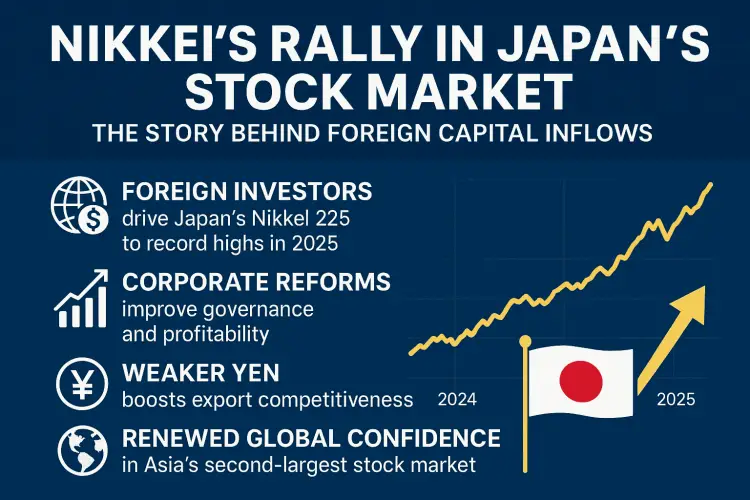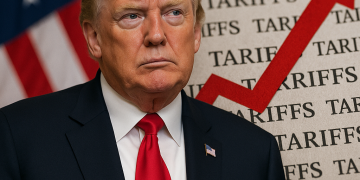The Nikkei’s Remarkable Comeback
In 2025, Japan’s Nikkei 225 has captured the spotlight with a rally not seen in decades. Once known for its “lost decades” of stagnant growth and deflation, Japan’s stock market is now shining brightly on the global stage.
This rally isn’t a mere coincidence—it’s the outcome of foreign capital inflows, structural reforms, and renewed investor confidence. With powerful momentum behind it, the Nikkei has become a symbol of resilience and renewal in the world’s third-largest economy.
Why Foreign Investors Are Flocking to Japan
Foreign capital is playing the lead role in this story. According to Tokyo Stock Exchange (TSE) data, overseas investors now account for more than 70% of daily trading volume. What is attracting them?
- Corporate Governance Reforms – Japan has pushed companies to focus on shareholder value, adopt better governance, and improve return on equity. These changes are creating more transparent and profitable firms.
- Weak Yen Advantage – A relatively weaker yen makes Japanese exports highly competitive, attracting foreign funds into manufacturing, tech, and automotive giants.
- Global Diversification – With uncertainty in U.S. and European markets, investors see Japan as a stable, undervalued, and opportunity-rich market.
- Geopolitical Shifts – Rising tensions in other parts of Asia have encouraged international funds to place long-term bets on Japan’s stability.
Japan’s Economic Revival
While foreign inflows fuel momentum, Japan’s domestic economy is showing renewed energy.
- Consumer spending is recovering steadily after years of sluggish demand.
- Inflation, once a missing ingredient, is now moderate and healthy, giving corporations room to grow revenues.
- Green energy, semiconductors, and robotics are emerging as strong drivers of Japan’s next growth chapter.
These developments are not just fueling short-term gains—they are helping Japan regain its position as a global investment powerhouse.
The Role of Technology and Innovation
Japan’s rally is powered not just by financial engineering but by real innovation. Companies like Toyota, Sony, SoftBank, and Tokyo Electron are expanding in AI, EVs, robotics, and advanced chips.
Foreign investors are particularly bullish on semiconductors, given Japan’s critical role in global supply chains. This positions Japan as a strategic growth hub amid the global tech race.
The Yen Factor: A Hidden Catalyst
One of the strongest forces behind foreign inflows has been the yen’s weakness. While a weaker currency typically signals concern, in Japan’s case, it supercharges export competitiveness.
For global investors, a weaker yen means they can buy Japanese assets at lower prices. As Japan’s corporations post record profits, the currency advantage is magnified, making Tokyo’s market extremely attractive.
How This Rally Differs from the Past
Japan has experienced rallies before, but today’s surge is structurally different.
- Past rallies were often speculative and unsustainable, tied to property bubbles or temporary stimulus.
- This rally is built on fundamentals—strong earnings, corporate reforms, and disciplined investment inflows.
That is why many analysts believe Japan’s current stock market growth is long-term and transformative, not just a passing trend.
Global Confidence in Japan’s Market
Major international funds, including those from the U.S., Europe, and the Middle East, are increasing their stakes in Japanese equities. Institutions such as BlackRock and Vanguard have publicly praised Tokyo’s reforms, adding to the rally’s legitimacy.
The Tokyo Stock Exchange’s move to streamline listings and encourage underperforming firms to improve capital efficiency has only strengthened trust among investors.
Opportunities for Everyday Investors
The Nikkei rally is not only for large institutions. Individual investors—both in Japan and abroad—can participate through:
- ETFs tracking the Nikkei 225
- Japanese equity mutual funds
- Direct investments in leading Japanese corporations
With transparency increasing and governance improving, everyday investors now have a clearer path to tapping into Japan’s growth.
Risks to Watch
No market is without risks. While the outlook for Japan remains bright, investors should consider:
- Global slowdown risks – A sharp downturn in the U.S. or China could spill over into Japan.
- Currency volatility – If the yen strengthens too rapidly, it could hurt exporters and reduce foreign inflows.
- Policy shifts – Changes in central bank policy or government direction may affect short-term performance.
Still, the balance of evidence suggests Japan is in a structurally positive phase that could continue for years.
The Bigger Picture: Japan’s Role in Global Markets
Japan is more than just another market—it’s becoming a central pillar in global financial strategy. Its reforms are serving as a model for other Asian economies, while its stock market is increasingly seen as a hedge against volatility elsewhere.
For global investors, the Nikkei rally represents not only short-term gains but also a vote of confidence in Japan’s long-term future.
Frequently Asked Questions
Q1: Why is the Nikkei rising now?
The rally is driven by foreign capital inflows, corporate reforms, a weaker yen boosting exports, and growing global investor confidence in Japan’s stability.
Q2: How do foreign investors impact Japan’s stock market?
They provide liquidity, push for stronger governance, and create upward pressure on valuations, making the market more attractive worldwide.
Q3: Is Japan’s rally sustainable?
Yes, because it is based on structural reforms, strong corporate earnings, and long-term investor inflows rather than short-term speculation.
Q4: How can I invest in Japan’s stock market?
You can invest via ETFs, mutual funds, or direct stock purchases in major Japanese companies listed on the Tokyo Stock Exchange.
Q5: What risks should I consider before investing?
Global economic downturns, currency fluctuations, and policy changes could affect performance. However, Japan’s fundamentals remain strong.
Conclusion: A New Dawn for Japan’s Market
The Nikkei’s rally in 2025 tells a powerful story of renewal, resilience, and global trust. Driven by foreign inflows, governance reforms, and corporate innovation, Japan’s stock market is no longer a sleeping giant—it is wide awake and charging ahead.
For investors, Japan represents more than an opportunity. It represents a chance to be part of a historic financial revival in one of the world’s most influential economies.
Author’s Note: This article was prepared by financial market researchers with expertise in global equities and Asian economies. The content is based on data from the Tokyo Stock Exchange, IMF reports, and leading financial research institutes to ensure accuracy and reliability.

































































